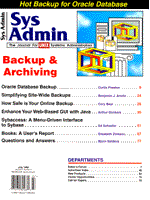
Editor's Forum
Earlier this year, I attended a Usenix conference and noticed that many, if not most, of the presenters were using a web browser as their presentation vehicle. By that, I mean the presenters had developed their visual aids as HTML documents hosted on their notebooks and displayed via some projection TV. In many cases, the speaker would tell the audience that the "slides" were also available for downloading or viewing at their web site. I thought, "that's clever." About two months later, I attended Software Development '96 and noticed several presenters doing the same thing. Oddly enough, that time I thought, "that's significant." I guess it's a matter of cognitive dissonance. Seeing a bunch of UNIX hacks doing the obvious (i.e., using a presentation engine_read web browser_to do presentations) with a tool from the UNIX environment seemed natural enough. Seeing a bunch of Windows and DOS hacks doing the same thing seemed like a event with significant portent. These two incidents aren't the only signs that something significant is going on. In December, I noticed a Florida mall kiosk that used Mosaic to present hypertext information about various merchants. The CD-ROM based proceedings at SD '96 were HTML-coded. If you've been reading past issues of this magazine carefully, you noticed several stories about companies that are using HTML for internal documents and data access engines. Compuserve recently announced that it will convert to HTML, and AOL has made a similar move. The significance of these developments is that we are (finally) seeing rapid convergence upon a standard for coding presentation (SGML/HTML). So far in the "computer revolution" we've seen this kind of convergence in data storage (ascii), information retrieval (sql), and data transmission and networking (IP), to name a few. This type of convergence always has radical impact upon markets and models. In fact, some authors have argued that "the information age" is really the result of information transmission and information storage converging upon a standard representation. Thus, although doing so risks feeding the hysterical web frenzy, I must point out that web browsers are, indeed, a big deal. Yes, they let you access a huge, unstructured, chaotic ocean of sometimes useful, frequently useless "information" on the Internet. But that isn't such a big deal in my book. What's important is that they also implement (for free) a general purpose presentation engine that will drive the acceptance of a common presentation markup language. Help engines, desktop publishing systems, visual aid authoring tools, CD-ROM presentation engines, interactive query systems, bulletin board systems, and other "specialized" presentation markets will all be radically affected. I have for some time been following SGML (HTML's meta-language)_watching for better support in DTP tools as a signal that it might fill this role. It looks like we're getting the less capable HTML instead. That's okay by me. HTML is not everything I'd like in a media-independent presentation language, but it's an adequate starting point and already has a huge user base. That "critical mass" of users will drive the enhancements necessary to address the most significant cross-media limitations. If you haven't thought about how a "presentation standard" affects your product or improves communication in your company, it's time to do so.
Sincerely yours,
|